Challenge and Opportunity
The keystone signs and their specially-designed ornate pole were products of Pennsylvania’s proud iron industry and worked together to make a strongly positive and memorable statement of place. However, recent treatments of the signs and poles make a less enthusiastic representation at best and, at worst, smack of a sad disinvestment in place. Contrast the beautiful and historically-accurate pairing of pole and sign and sensitive treatment of the wonderfully-restored Little Pine Creek sign on the homepage with those markers that follow. By failing to repair damaged markers and replace missing ones, we are losing a tremendously-effective and easily met opportunity to show pride in our places and to educate young people about proper stewardship of their homeplaces.
Repair and Accurate Replacements
Many markers are in great need of care, as these photos demonstrate. Just below them are some photos of recent modern imitations of the classic originals. These “replicas” underscore the need to develop true-to-the-original verions of the keystone markers. We are currently developing this capability.
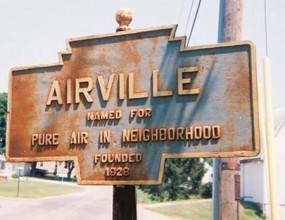 |
Airville’s marker is rusting and deteriorating. However, its condition is still better than many of the Commonwealth’s other markers. These markers literally have our special places written all over them and therefore should be treated with a deference indicative of our pride of place. This one has been nicely repainted recently by someone local. |
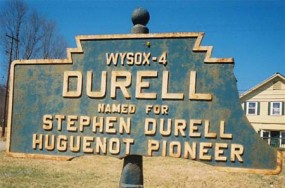 |
Durell’s sign will need to be re-cast. A set of patterns created by the Keystone Marker Trust can assist in this effort. |
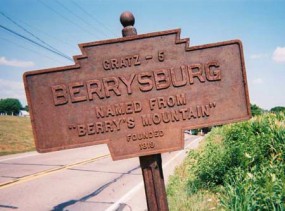 |
Like hundred of markers across the Commonwealth, Berrysburg’s marker is leaning and in need of paint. Other markers, as depicted here, are in even worse shape. The potential for adopting a marker to be used as a teaching tool and as a means to get young people to invest in the places where they live must be realized. (2019) Sadly this marker and its original post have disappeared from the roadside. |
 |
Some paint and TLC will bring Mandata’s marker’s former splendor back very easily. Pennsylvania’s colorful town names are brought to light by the markers. We suspect Pillow, PA, must be a very comfortable place indeed. |
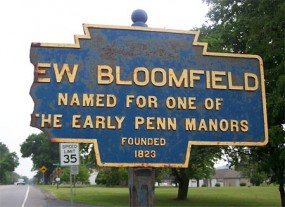 |
Another marker in need. The markers are monumental gateways to our places. A sign in this condition does not give a good first impression of a town founded in 1823. Good news here. This marker has been repaired and repainted, and the town relocated both of their remaining markers. One is now on the lawn of the county courthouse; the other in front of the library. |
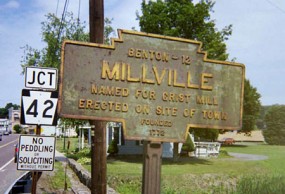 |
Many markers have lost the ball finials that graced the top of the pole, as we see with Millville’s marker (compare with the previous photo of New Bloomfield’s marker to see the finial). Additionally, Millville’s sign is leaning and in need of paint – also common complaints among uncared for markers. |
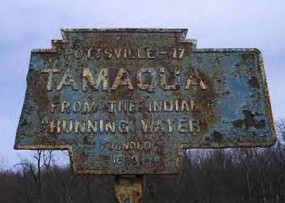 |
Surely the beautiful town of Tamaqua has more pride in itself than the condition of its iconic marker would suggest! Sadly this one too is now long gone. |
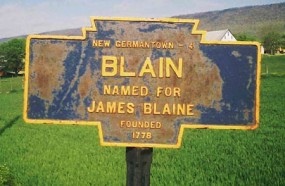 |
Blain’s marker needs to be repainted and have its ball finial replaced. The sign is also not sitting square on its pole. (2019) Both of the surviving markers here have been repaired and repainted |
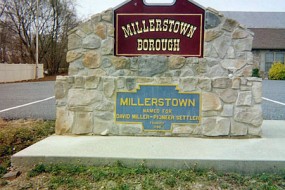 |
While the restoration of the sign in Millerstown should be applauded, it has left the sign bereft of its character-defining pole and placed it in a location and context where it would not have been historically. Part of the problem for towns looking to restore a marker has been that once restored, current PennDOT thinking is that the marker’s poles need to be of the break-away variety or the markers must be re-located behind a barrier. The Keystone Marker Trust is working to develop guidelines and new poles that address safety concerns but leave a greater range of options on a case-by-case basis. |
Can’t Beat the Real Thing
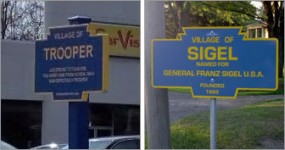 New spins on the old form are decidedly lacking of the strong presence of the originals they imitate. The Sigel sign, mounted on a piece of pipe, is merely a piece of sheet aluminum and lacks the projection of solidity and monumentality the original gave to the town. The signs in Trooper (pictured here) and Eagleville are also new creations and wildly distort the proportions, font, text, material, and detail of the originals.
New spins on the old form are decidedly lacking of the strong presence of the originals they imitate. The Sigel sign, mounted on a piece of pipe, is merely a piece of sheet aluminum and lacks the projection of solidity and monumentality the original gave to the town. The signs in Trooper (pictured here) and Eagleville are also new creations and wildly distort the proportions, font, text, material, and detail of the originals.
Modern treatments of original signs are also unfortunate, by and large, because they usually involve moving the marker or discarding the historic pole. Such is the case in Schwenksville, where the historic pole—which was specially designed for the marker—was discarded in favor of a piece of pipe. In Millerstown, the sign was removed from its pole and put in a stone wall, entirely changing the character of its presentation. Lastly, as the markers at Intercourse, Mifflintown, and Roaring Branch show, nothing detracts from a marker than obstructing it with signage that could just as easily be placed even a few feet away. [ The original iron markers for the Jefferson County town of Sigel were found hidden away in a shed. They have now been repainted and reinstalled on the roadsides. Signless posts from other locations were used here.]
 New spins on the old form are decidedly lacking of the strong presence of the originals they imitate. The Sigel sign, mounted on a piece of pipe, is merely a piece of sheet aluminum and lacks the projection of solidity and monumentality the original gave to the town. The signs in Trooper (pictured here) and Eagleville are also new creations and wildly distort the proportions, font, text, material, and detail of the originals.
New spins on the old form are decidedly lacking of the strong presence of the originals they imitate. The Sigel sign, mounted on a piece of pipe, is merely a piece of sheet aluminum and lacks the projection of solidity and monumentality the original gave to the town. The signs in Trooper (pictured here) and Eagleville are also new creations and wildly distort the proportions, font, text, material, and detail of the originals.







